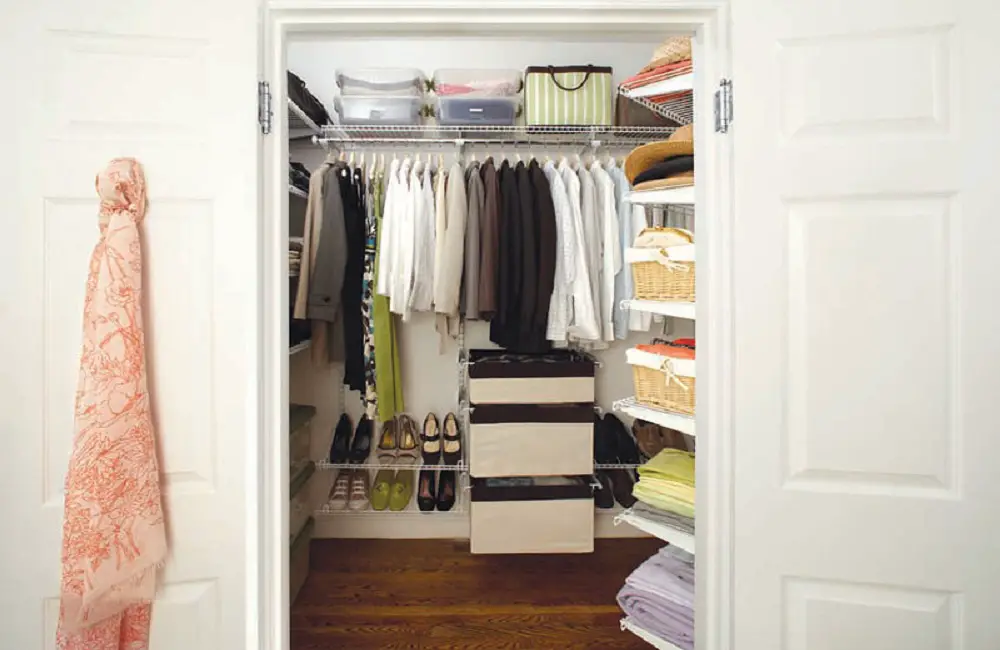Having limited closet space can be a common challenge, especially with ever-changing fashion trends. As a result, it’s easy to accumulate more clothes than necessary, leading to an overflowing closet that becomes difficult to manage and navigate. To address this issue, consider decluttering your closet as a practical solution.
Start by sorting through all of your clothing items and make decisions on what to do with each piece. Consider donating, selling, or even discarding clothes that you no longer use or need. Furthermore, take the time to mend any garments that can be fixed, and only keep items that fit you well and that you genuinely love.
To maintain a clear and organized closet, consider rotating your clothes according to the seasons. This approach allows you to have a more manageable selection of clothes readily available while making room for new pieces. Finally, when shopping for new items, be intentional with your choices to ensure they align with your personal style and needs.

By following these steps, you can improve the structure and organization of your closet and create a space that is functional, clutter-free, and reflects your personal style.
When it comes to parting ways with possessions we’ve held onto for some time, it can often be a challenging task. These items may hold sentimental value as they remind us of precious memories or have been gifted by someone special. Regardless of the reasoning behind keeping them, the presence of unused items is ultimately unhelpful.
Fortunately, there are several straightforward methods available that can assist in the process of decluttering your closet, leaving you with a sense of accomplishment and satisfaction. To learn more about these effective techniques, continue reading below.
When To Purge Your Closet
Knowing when to purge your closet can make a huge difference in organization and efficiency. If you find yourself struggling to close your closet doors or constantly tripping over shoes, it’s a clear sign that it’s time to declutter. Even if your closet isn’t overflowing, there’s a good chance you have clothes you haven’t worn in years. In these cases, it’s best to let go and allow others to enjoy them.
Decluttering your closet can be an incredibly rewarding and liberating experience. Let’s embark on this journey together, transforming your cluttered closet into a stylish and clutter-free space. With a bit of effort and attention to detail, you can achieve a well-organized and functional wardrobe that reflects your personal style.
How To Declutter Your Closet In 6 Easy Steps?
Empty the Closet
To begin the process of decluttering your closet, it is important to gather all of your clothing, including shoes, accessories, and any other items, in one designated area. The purpose is to completely empty your closet, creating a blank canvas for your organization efforts.
This is also an opportune time to thoroughly clean your closet space. Vacuum and wipe down all surfaces, ensuring a fresh and clean environment in which to organize and store your belongings. Consider using a small amount of air freshener to enhance the overall ambiance of the space.
Additionally, it is crucial to diligently collect your clothing from all areas of your living space, including the washing machine, couch, car, and any other locations where they may have accumulated. By doing so, you can ensure that no articles of clothing are overlooked during the decluttering process.
Sort the Clothes
When organizing your clothes and accessories, it can be helpful to sort them into five distinct categories. Take the time to try on certain items as well. As you make decisions about each piece, consider placing them in one of the following piles:
- Love it, and I’m keeping it!
- Mend it if necessary.
- Donate it to someone in need.
- Sell it for some extra cash.
- Determine if it belongs in the trash.
It’s important to acknowledge that this process can be challenging, as our minds tend to play tricks on us. You may find yourself thinking thoughts like, “This item is too small now, but I’ll hold onto it for when I lose weight,” or “I can’t get rid of this; my aunt really likes it.”
However, these types of thoughts often lead to unnecessary accumulation of items and clutter in our homes. Remember that you are purging your closet for a reason – to create a clean, organized space where you can easily find and enjoy the clothes you love.
When these intrusive thoughts arise, it’s crucial to stay strong and focused on your goal. Keep pushing those thoughts aside, knowing that your aunt is unlikely to notice the missing blouse, and that once you achieve your desired weight loss, you can treat yourself to a new pair of jeans. For now, keep your primary objective in mind: achieving a clear and clutter-free closet.
A “Maybe Bin” to the Rescue
One approach to being more forgiving with yourself is to create a designated “maybe” bin. This bin is meant for garments that fit you adequately and are somewhat pleasing, even if not entirely adored. Store these items in the bin and set a time limit, such as six months. If you haven’t worn the items within this period, consider donating or selling them.
After sorting through your clothing and finalizing your piles, gather bins or trash bags, along with tape and a marker. Label the containers or bags according to the following categories:
- Mend it: Clothes in need of repair or alterations.
- Donate it: Clothing that can be given to those in need or to charitable organizations.
- Sell it: Clothes that you could potentially sell to others.
- Trash it: Items that are no longer usable and should be discarded.
By implementing this method, you can streamline the organization of your wardrobe and make more informed decisions about what to do with your clothing items.
Get Rid of Decluttered Items Immediately
To ensure an organized living space, it is recommended to promptly dispose of the trash to prevent any future reconsiderations. Additionally, place the bags designated for mending and donation near the exit, to be taken out alongside your closet organization.
Similarly, position the “sell bag” conveniently near your laptop or by the door, depending on your preferred selling location. Lastly, allocate a designated space inside your closet for items that you are unsure about, often referred to as the “maybe bin”.
Organize Your Closet
Now that you have sorted out and kept only the clothes that fit you well and that you truly love, it is the perfect time to effectively organize your closet. It is important to consider a few key recommendations before putting everything back in its place.
Things You Shouldn’t Keep in Your Closet
Generally, closets are primarily designated for clothing storage. However, over time, they tend to accommodate various items loosely associated with clothing. When undertaking the task of decluttering your closet, it is important to assess which items can be removed to optimize the cleanliness, organization, and functionality of the space. In this regard, I highly advise you to consider removing the following items:
Jewelry
When it comes to storing jewelry, it’s best to avoid keeping it with your clothes in the closet. Jewelry is usually delicate, and the limited space in the closet increases the risk of damage.
To ensure the safety of your precious pieces, consider storing them on your dresser or displaying them on a stand outside your closet. Keeping them in a separate area will minimize the chances of any mishaps occurring.
Jackets, Coats, And Rain Boots
Jackets, coats, and rain boots, while technically considered clothing, are best stored in a separate area rather than a closet. These bulky items, often damp, tend to take up valuable space, potentially leaving other garments moist.
The presence of damp clothing and boots in an enclosed and poorly ventilated closet can promote the growth of mold, mildew, and unpleasant odors. This, in turn, can compromise the freshness and integrity of your other clothing.
To prevent such issues, it is advisable to designate a specific space, located outside of your closet, where you can store your jackets, coats, and rain boots. By doing so, you will allow them to adequately dry out without affecting your other garments.
Luggage
Luggage occupies a significant amount of space in a closet, much like coats. If there are no opportunities to store handbags or other miscellaneous items inside the luggage, it is advisable to consider alternative storage options such as the garage, basement, or additional storage space. This will help create a more organized and clutter-free living environment, allowing for effective utilization of available space.
Food Items
It is not advisable to keep chocolate in your closet, even if you want to hide it from your children. This is because pests have a keen sense of smell and can easily detect food products. When pests infest your closet, it can lead to damaged clothing and unpleasant odors.
To ensure the safety of your food products and prevent any issues, it is recommended to store them in a secure location, such as the kitchen or pantry, away from your clothing and other items. This practice will help maintain the freshness of your food and preserve the integrity of your closet.
Excess Hangers
To properly organize your excess hangers, it is recommended to store them in a designated bin or basket rather than hanging them on your railing. Hanging them on your closet bar can consume valuable storage space, potentially limiting the available space for your clothing items.
However, it is still advisable to keep the excess hangers easily accessible in proximity, ensuring that they are readily available whenever you need them. This way, you can conveniently locate and use them as required.
Final Thoughts
When purging your closet, it’s important to approach it with a mindset of clarity and keep your end goal in mind. To start, take an inventory of all your clothes and accessories. Assess each item and categorize them into three groups: donate, trash, and sell. Get rid of anything that you no longer find useful or relevant.
For the items you love and use regularly, consider repairing any damages and keep them. Finally, thoroughly clean and organize your closet, ensuring that you only keep what is necessary for easy access and optimal functionality.

